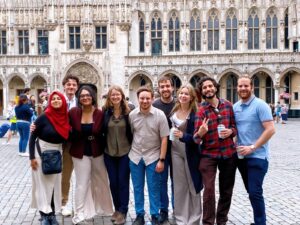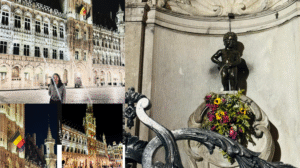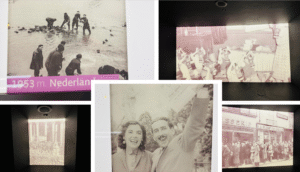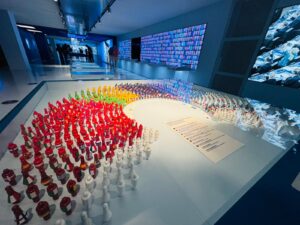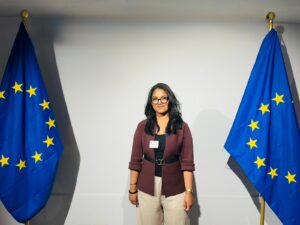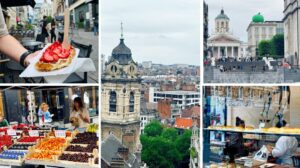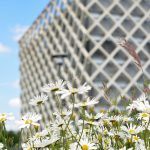A Student Experience at the European Commission
Thinking about studying in Europe? Curious what a real WUR food law Brussels trip looks like from a student’s perspective? I recently got the chance to find out for myself!
As a student at Wageningen University and Research (WUR), I joined a one day trip to Brussels with the Food Law Chair Group, where we visited the European Commission, the actual place where EU policies are made.
It wasn’t just lectures and PowerPoints. We saw how everything we talk about in class plays out in real life how food law connects with climate, trade, innovation and more. Plus, we explored the city, shared good food, and had great conversations along the way. Definitely one of those “this is why I chose WUR” moments
A Special Invitation for Food Law Students
Every year, the Food Law Chair Group invites a select group of students to take part in this exclusive, invitation-based trip to the European Commission in Brussels. What makes it even more special? The trip is fully funded by the university including travel, accommodation, and meals.
It’s one of the many ways WUR connects classroom theory with real world institutions and brings students closer to the legal and political processes that shape food systems on a European scale.
Let me take you through the entire WUR food law Brussels trip.
Day Before: A Cultural and Culinary Welcome
To make the most of the experience, many of us arrived in Brussels a day early, joined by other EU-focused students from our cohort. We kicked things off with a lively Indian dinner, generously covered by the university. It turned into a great moment of connection, laughs, shared stories, and lots of excitement for the next day’s visit.
After dinner, we explored Brussels by night, walking through the city center, admiring the illuminated Grand Place, visiting the quirky Manneken Pis, and gazing at the beautiful Royal Palace. Of course, we couldn’t resist the Neuhaus chocolate shops and local souvenir stalls. This was Belgium, after all!
Morning of the Visit: Museums and Mindset
The next morning, before heading to the European Commission, we stopped by a museum that really set the tone for the day. It walked us through some of Europe’s most defining and difficult moments from the destruction of Belgian towns during World War I, to Mussolini’s rise in Italy, and the chilling racial “Aryan tests” of the Nazi era.
One part that stuck with me was the story of the 1958 Benelux Agreements, a quiet but powerful example of cooperation between Belgium, the Netherlands, and Luxembourg that eventually helped shape today’s European Union.
Walking through those rooms made it clear that the EU is not just about policies and treaties. It was built out of a need to prevent history from repeating itself. The visit gave a human perspective to the policy discussions we would be having later that day and reminded us why these institutions matter in the first place.
Inside the Parlamentarium: Democracy Made Visible
One of the things that really stood out was a vibrant exhibit at the Parlamentarium, the European Parliament’s visitor center. At first glance, it looked like an art piece, hundreds of colorful figurines arranged in a circular hall. But each figure represented a real Member of the European Parliament (MEP), grouped not by nationality but by political party.
All around us, videos of real speeches, debates, and votes played on huge screens. Suddenly, the idea of European democracy didn’t feel so distant or abstract. It felt real and alive.
For me, it was a powerful reminder that behind the laws and policies we study at WUR are real people making tough decisions, negotiating across borders, and representing millions of voices. It’s not just about legal texts. It’s about people, politics, and the process of working together in a shared space.
EU Stepping into the European Commission
After lunch, we made our way to the Charlemagne building, home to several departments of the European Commission. After a quick security check and group photo, we were welcomed inside for an afternoon of high-level learning.
We attended three presentations that offered us a rare glimpse into how EU governance actually works:
- Shaping Europe’s Future – The European Commission at Work
- EU Bioeconomy Policy and Strategy
- EU Policies for Sustainable Prosperity and Competitiveness
Each session showed how interconnected and forward-looking EU policymaking is, especially when it comes to food law, sustainability, and innovation. Hearing directly from Commission staff about how policies are designed and implemented gave us a completely new perspective beyond the classroom.
Heading Home Inspired
After the final session, we made our way back to the train station and returned to Wageningen, still buzzing with ideas and reflections. On the train, we chatted about how we could apply this knowledge in our thesis work, how food policy ties into everything from economics to ethics, and how lucky we felt to be part of this learning journey.
Why This Trip Matters
This trip wasn’t just about walking through EU buildings. It was about experiencing how policy really works. At WUR, I always felt that we don’t just learn from textbooks, instead meet the people behind the laws, explore how decisions are made, and understand how food law connects to public health, trade, sustainability, and innovation.
And it wasn’t just about academics either. It was about connecting with classmates, laughing over dinner, wandering a new city, and turning classroom theory into something we could actually feel and understand.
The best part? Experiences like this are part of Wageningen’s academic culture. If you’re interested in where policy meets practice, I definitely recommend exploring the Food Law and Regulatory Affairs specialisation
Thanks for reading!
If you’re curious about studying Food Quality Management at WUR or just want to chat, I’d love to connect, Talk to me on Unibuddy
Warm regards,
Devi


